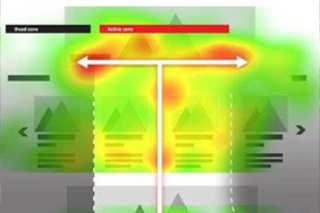News Archive
Biz Researchers Study What You're Missing When You Look Over an Online Menu
By Keith Morelli

TAMPA (September 8, 2021) -- With the aid of emotional AI tools, researchers with the USF Center for Marketing and Sales Innovation have taken a hard look at online menus’ composition to determine what is appealing to customers and what remains hidden in plain sight.
The study represented the most recent partnership between the private sector and the university and has resulted in impactful research that can inform the hospitality industry as it ushers in a new era of online menus for in-house eating, take out and delivered meals.
“In the past 18 months, we’ve undergone a seismic shift in the way our customers interact with our menu,” said Sara Bittorf, Chief Experience Officer at TGI Fridays. “The research has already given us tools to improve the guest experience and to increase menu profitability. We’re looking forward to exploring further menu engineering insights as the research proceeds.”
Rob Hammond, the study’s primary investigator and director of the center, said the center’s research lab has a growing list of private partners who make use of the unique and relevant data generation techniques that can help boost bottom lines. The added benefit is that current and past students have the opportunity to play a big part in creating research with impact.
“Students are learning state-of-the-art skills and participating in research,” Hammond said, “that will make them more employable at graduation.” The lab is part of what makes USF a leading research institution, he said. Other studies conducted at the lab have included examining the effectiveness of tobacco cessation public service announcements, salesperson effectiveness and COVID-19 messaging.
The menu research involved a system that was used as a result of a collaboration between iMotions and USF to allow data collection and research remotely using a respondent’s web camera to collect eye tracking and facial expression data, Hammond said.
“Once the data is collected,” he said, “the information is analyzed using the center’s Customer Experience Lab tools.”
Graduate student Yuqi Wang conducted much of the biometric data analysis on the project. She said such research fosters creativity and motivation on her part and produces relevant and impactful findings that can help business partners thrive.
“For me, it is a process that keeps exploring the infinite world with limited data,” she said. “Participating in the project team made me feel confident and motivated. I believe taking small steps every day enables me to one day reach new heights.”
Lab partner Revenue Management Solutions (RMI), a consulting company that provides data-driven solutions and services to the restaurant industry, said the research will help restaurants design online menus that are easier to navigate. TGI Fridays volunteered to participate in the project, allowing its online menus to be studied.
“It’s exciting to participate in this public – private research collaboration with USF and iMotions,” said RMI study team leader Christina Norton who is also a graduate of the USF Doctor of Business Administration program. “This research has timely insights that help the hospitality industry address operational challenges associated with changing expectations and behaviors of the consumer over the past 18 months.”
“Early results could mark big learning for restaurants,” said a news release issued by RMS earlier this month. “Distinct search patterns revealed blind spots when online menus are reviewed on a desktop. Additionally, researchers were able to evaluate the impact of suggestive selling opportunities within the ‘buyer’s journey’ of online ordering, a set of discrete phases uncovered during analysis.”
Research revealed, for example, a persistent blind spot on the left side of the online menu. Though each respondent looking over the menu had a unique path, many started with a site’s main menu categories such as appetizers, sandwiches, etc., reading those from left to right. The focus then shifted down towards the center of the screen, and further attention involved navigation predominantly to the right of the center.
Results show that approximately 50 percent of the time, respondents missed items shown on the left of the screen altogether. The joint study team also observed four discrete phases with mental tasks and outcomes for each, including familiarization, in which respondents scanned the full menu/website and exploration, in which respondents narrowed and evaluated choices. Other phases included affirmation, where respondents began adding items to the cart while toggling back to menu options to add or search additional items, and confirmation, in which respondents completed check-out.